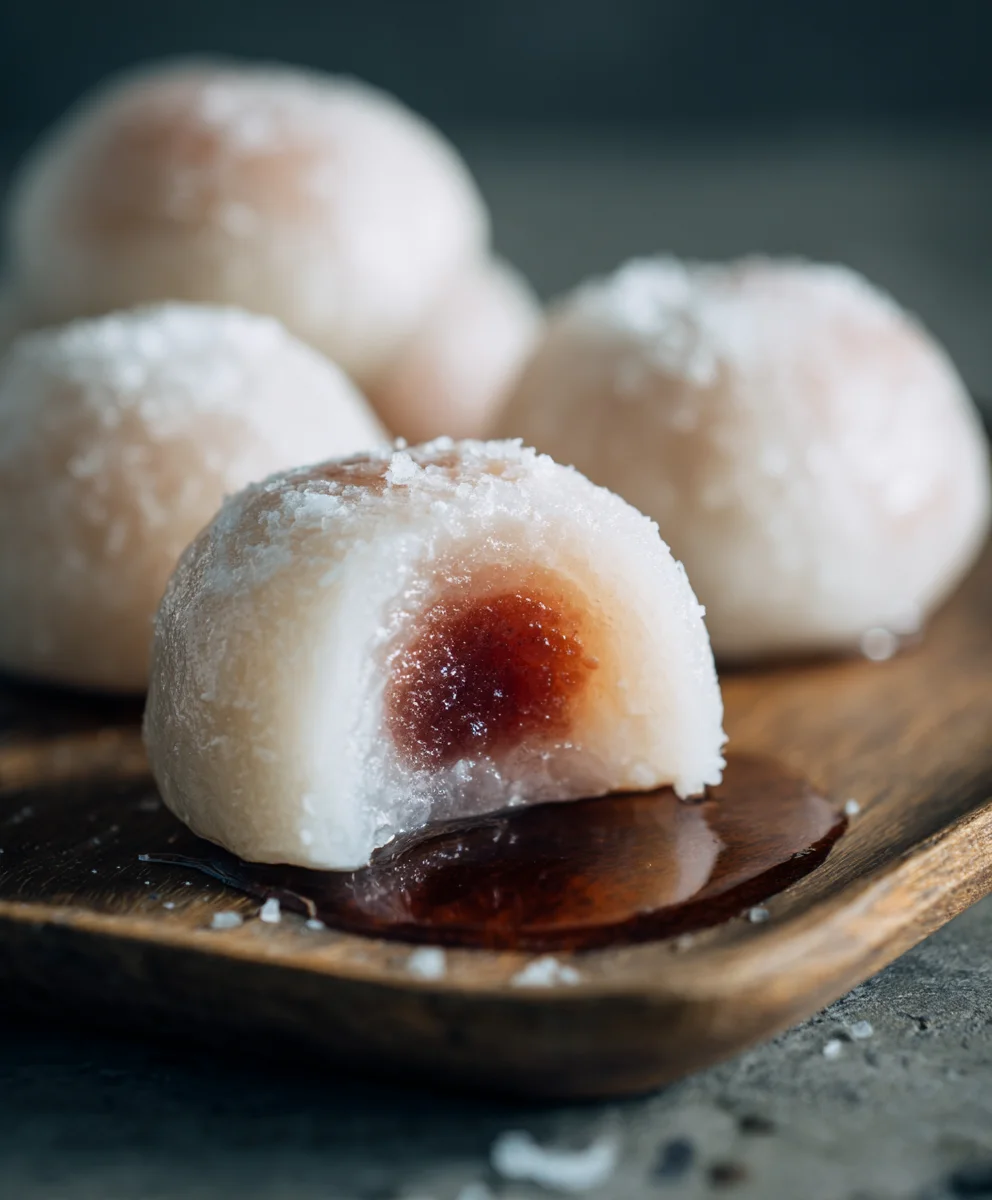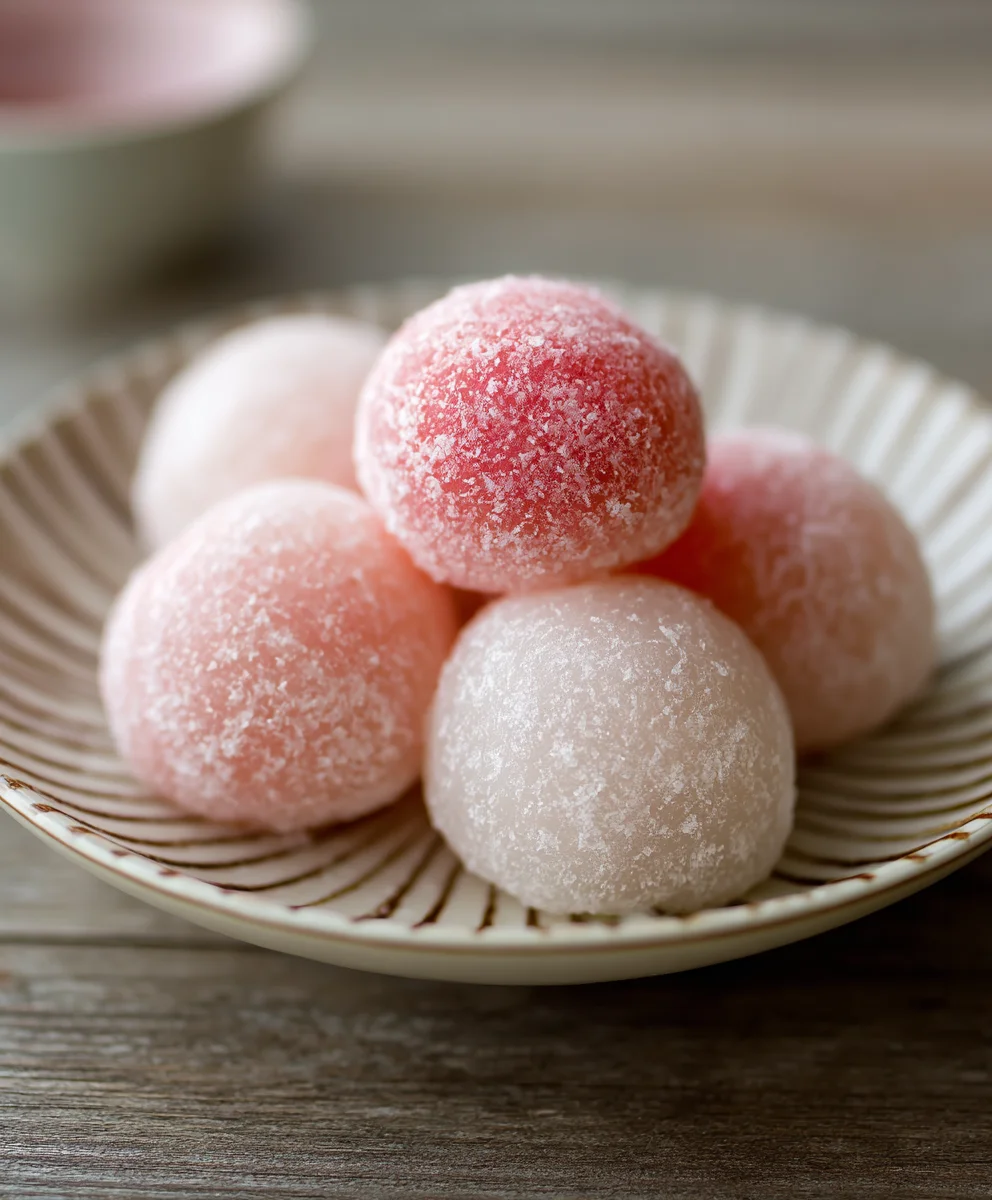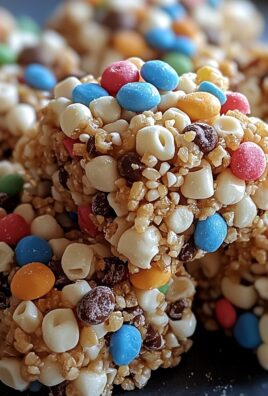Easy Hanami Dango Recipe is a truly delightful way to embrace the spirit of spring, even if you’re thousands of miles from Japan’s iconic cherry blossoms. Picture this: a gentle breeze, soft pink petals drifting through the air, and in your hand, a skewer of beautifully colored, perfectly chewy dango. This isn’t just a snack; it’s an experience deeply rooted in Japanese culture, a quintessential treat enjoyed during ‘Hanami’ – the beloved tradition of cherry blossom viewing.
Why We Adore Hanami Dango
The charm of Hanami Dango lies not only in its vibrant, symbolic colors—pink for blossoms, white for the last snow of winter, and green for new life—but also in its unique texture and delicate flavor. Each bite offers a satisfyingly soft yet wonderfully chewy consistency, a delightful mochi-like bounce that is subtly sweet without being overwhelming. It’s comforting, aesthetically pleasing, and a perfect complement to a cup of green tea, making it a beloved treat across generations.
While the thought of making traditional Japanese sweets might seem daunting, I’m here to assure you that crafting your own Hanami Dango is surprisingly simple and incredibly rewarding. My aim with this Easy Hanami Dango Recipe is to demystify the process, making it accessible for everyone, regardless of their culinary experience. Get ready to create these charming, delicious skewers that will transport your taste buds straight to a spring festival under the cherry trees, right from your own kitchen!
Ingredients:
- 150g Shiratamako (Sweet Rice Flour): This is the star of our dango! Shiratamako is a type of glutinous rice flour that gives dango its signature chewy, yet tender texture. It’s often granulated, looking like small pearls. I find it produces the best results for a truly authentic bite, offering that delightful springiness we all love. It’s crucial for the mochi-mochi texture.
- 50g Jōshinko (Non-Glutinous Rice Flour): While Shiratamako provides chewiness, Jōshinko adds structure and prevents the dango from becoming overly soft or sticky. It’s a non-glutinous rice flour, which means it helps balance the texture, making our dango pleasantly firm yet still wonderfully tender. The combination of these two flours is what makes this an Easy Hanami Dango Recipe deliver perfect results every time.
- 30-40g Granulated Sugar: This adds a subtle sweetness to the dango itself. I usually start with 30g, but if you prefer a slightly sweeter base, you can go up to 40g. Remember, dango often gets served with additional sweet toppings, so a mild sweetness in the dango itself is generally preferred.
- Approximately 160-180ml Hot Water (around 80°C/175°F): The temperature of the water is quite important here! Using hot water helps to “gelatinize” the starches in the rice flour, making the dough much easier to work with and resulting in a smoother, more pliable consistency. I usually heat my water until it’s steamy but not quite boiling, then let it cool for a minute or two. The exact amount can vary slightly depending on your flour’s humidity, so I always recommend adding it gradually.
- Red Food Coloring (or pink, a few drops): For the iconic pink dango. I use just a tiny drop or two to achieve a delicate pastel pink, reminiscent of cherry blossoms. You can also use natural alternatives like strawberry powder for a subtle flavor hint and color.
- Green Food Coloring (a few drops): To create the vibrant green dango. Again, a small amount goes a long way. Matcha powder is a fantastic natural alternative that will also infuse a lovely, earthy tea flavor into your green dango.
- Bamboo Skewers: You’ll need about 8-10 skewers, typically 15-20cm (6-8 inches) long, to assemble your beautiful Hanami Dango. If you can, soak them in water for about 30 minutes before use; this helps prevent the dango from sticking and makes skewering easier.
- Ice Bath: Prepare a large bowl of ice water before you start cooking. This is crucial for stopping the cooking process and ensuring your dango retain their lovely chewy texture. I usually fill a bowl with cold water and a good amount of ice cubes.
Preparing the Dough for Your Easy Hanami Dango
Step 1: Combining the Flours and Sugar
-
Mixing Dry Ingredients Thoroughly
In a large mixing bowl, I carefully combine the 150g of Shiratamako, 50g of Jōshinko, and the 30-40g of granulated sugar. I always make sure to whisk these dry ingredients together really well. This ensures that the two types of rice flour and the sugar are evenly distributed throughout the mixture. A well-mixed dry base is the first step to achieving a consistent dough texture, which is absolutely essential for perfectly chewy dango. I often use a fine-mesh sieve to sift the flours and sugar together; this helps to break up any lumps in the flour, making the dough even smoother later on. Don’t skip this step, as flour lumps can lead to inconsistencies in your finished dango.
Step 2: Hydrating the Mixture with Hot Water
-
Gradually Incorporating the Warmth
Now, it’s time to add the hot water. I pour about 160ml of the hot water into the dry flour mixture, stirring constantly with a sturdy spatula or a pair of chopsticks. The hot water is key here because it starts to “cook” the flour slightly, making the dough more pliable and easier to work with. I watch the mixture carefully; it will start to come together into a shaggy dough. If it still looks too dry and crumbly, I add the remaining 20ml of hot water, a tablespoon at a time, until it forms a cohesive mass. The goal is to achieve a dough that is soft, but not sticky, and holds its shape when pressed. It should feel warm to the touch. Once it’s cool enough to handle, I usually switch from the spatula to my hands to gently knead the dough within the bowl for about 2-3 minutes. This light kneading helps to bring it all together smoothly without overworking it. You want a consistent, smooth ball of dough.
Step 3: Dividing and Coloring the Dough
-
Creating the Signature Hanami Hues
Once I have a smooth, pliable white dough, I divide it into three equal portions. This is where the Hanami (flower-viewing) magic happens!
- First Portion (White): I leave one portion as is. This will be our classic white dango, representing the purity and simplicity of cherry blossoms. I usually give it a quick knead again to ensure it’s perfectly smooth.
- Second Portion (Pink): I take the second portion and flatten it slightly. Then, I add 1-2 drops of red or pink food coloring to the center. I then knead the dough gently and thoroughly until the color is evenly distributed and I have a beautiful, soft pastel pink. It’s important to knead well to avoid streaks. If you’re using a natural powder like strawberry, you might need to add a tiny bit more water, a quarter teaspoon at a time, to maintain the correct dough consistency, as powders can absorb moisture. I love how this vibrant pink reminds me of the delicate petals of sakura.
- Third Portion (Green): For the final portion, I repeat the process, adding 1-2 drops of green food coloring. I knead it until it’s uniformly green. Again, if using matcha powder, you might need a tiny splash of water. The green typically symbolizes the fresh leaves and grass of spring, completing the Hanami aesthetic.
After coloring, I usually roll each colored dough ball lightly between my palms to ensure they are smooth and ready for shaping. It’s important to keep the dough covered with plastic wrap or a damp cloth if you’re not shaping them immediately, to prevent them from drying out. This ensures your dango remain soft and easy to work with.
Forming Your Delightful Dango Balls
Step 4: Rolling the Dango
-
Shaping Each Small Sphere with Care
Now comes the truly enjoyable part – shaping the dango! I take each colored dough portion and roll it out into a log shape, about an inch in diameter. Then, I divide each log into roughly 8-10 equal pieces. The goal here is to make each piece about 10-12 grams, which will result in dango balls about 2-2.5cm (approximately 1 inch) in diameter. Consistency in size is important so they cook evenly and look uniform on the skewer.
From each small piece, I carefully roll it between my palms to form a smooth, perfect sphere. I try to apply gentle, even pressure to prevent cracks. If you find the dough cracking, it might be a little dry; you can try wetting your hands very slightly or kneading in a tiny bit more warm water if necessary, but this is rare if your initial dough consistency was correct. I focus on creating really round, uniform balls. This step takes a bit of patience, but it’s part of the meditative process of making this Easy Hanami Dango Recipe. I always cover the finished dango balls with plastic wrap or a damp cloth as I work, so they don’t dry out while I’m shaping the rest. This recipe should yield about 24-30 dango balls in total, depending on their size.
Cooking the Easy Hanami Dango to Perfection
Step 5: Boiling the Dango
-
The Crucial Cooking Process for Chewy Perfection
I bring a large pot of water to a rolling boil over high heat. It’s important to use a generously sized pot with plenty of water, as this prevents the temperature from dropping too much when you add the dango and allows them to cook evenly without sticking to each other.
Once the water is boiling vigorously, I gently drop the dango balls into the pot, a few at a time. I make sure not to overcrowd the pot; this is critical. If you add too many at once, the water temperature will drop, and the dango might not cook properly or could become gummy. I usually cook about 10-12 dango at a time, depending on the size of my pot. They will sink to the bottom initially.
I let them cook. After a few minutes, you’ll see them float to the surface. This is a good sign, but they aren’t quite done yet! Once they float, I let them cook for an additional 1-2 minutes. This extra minute or two ensures that the dango are cooked all the way through, resulting in that perfectly tender yet chewy texture. If you pull them out too early, they can taste chalky in the center. I constantly monitor the boil to ensure it remains steady throughout the cooking process.
Step 6: The Refreshing Ice Bath
-
Stopping the Cooking and Ensuring Optimal Texture
As soon as the dango have cooked for that extra 1-2 minutes after floating, I carefully scoop them out of the boiling water using a slotted spoon or a fine-mesh skimmer. Immediately, I transfer them directly into the prepared ice bath. This step is just as important as the boiling itself! The cold water instantly stops the cooking process, which is essential for achieving that delightful, springy, and chewy texture without them becoming overly soft or mushy. It also prevents them from sticking together.
I let the dango cool in the ice bath for at least 3-5 minutes, until they are completely chilled. I might even gently swirl them around in the ice water to ensure even cooling. Once they are thoroughly cooled, I remove them from the ice bath and drain them well on a wire rack set over a baking sheet, or on a plate lined with paper towels. I want to make sure any excess water is removed before skewering, as this helps them adhere to the skewer better and prevents them from being watery. They should feel wonderfully bouncy and slightly firm to the touch.
Assembling and Serving Your Easy Hanami Dango
Step 7: Skewering the Dango
-
Bringing the Colors Together on a Skewer
With the dango nicely chilled and drained, it’s time for assembly! This is where the beauty of Hanami Dango truly shines. I take one of my pre-soaked bamboo skewers.
The traditional order for Hanami Dango is pink, white, and green. So, I carefully thread one pink dango onto the skewer first. I try to push it gently through the center, being careful not to push too hard, which could deform the dango. Then, I follow with one white dango, and finally, one green dango. This creates the classic trio of colors that symbolizes the arrival of spring – pink for the cherry blossoms, white for the lingering snow or the pure beauty of the petals, and green for the fresh leaves and new growth.
I repeat this process with the remaining dango and skewers until all the dango are beautifully arranged. This recipe typically yields enough dango to make about 8-10 skewers, each holding three dango balls. If you find your dango are sticking to the skewer, try wetting the skewer slightly before threading the dango. This simple trick makes the process much smoother. The visual appeal of these colorful skewers is truly satisfying, making them a perfect treat for spring celebrations or just a lovely afternoon snack.
Step 8: Serving Suggestions and Enjoyment
-
Enjoying Your Homemade Treat to the Fullest
Your homemade Easy Hanami Dango Recipe has culminated in these beautiful, delightful skewers, and they are now ready to be enjoyed!
I love serving these dango fresh, as their texture is at its absolute best when enjoyed shortly after preparation. They are wonderful on their own, offering a subtle sweetness and that irresistible chew. However, for an extra touch of flavor and elegance, there are many traditional ways to enjoy them:
- Kinako (Roasted Soybean Flour): I often dust them with kinako for a nutty, earthy flavor that pairs beautifully with the dango’s mild sweetness. Just pour some kinako onto a plate and gently roll the dango skewers in it.
- Mitarashi Sauce: This is a classic choice! Mitarashi sauce is a sweet and savory glaze made from soy sauce, sugar, and mirin, thickened with a bit of starch. I usually drizzle it generously over the dango. The contrast between the chewy dango and the glossy, umami-rich sauce is simply divine.
- Anko (Sweet Red Bean Paste): For those with a sweet tooth, a dollop of smooth or chunky anko served alongside, or even spread directly onto the dango, is a fantastic option.
- Green Tea: A warm cup of unsweetened green tea is the perfect accompaniment. Its slight bitterness cleanses the palate and complements the dango’s sweetness beautifully.
Storage: If you happen to have any leftover dango (which is rare in my house!), they are best eaten on the same day. The texture of dango can harden and become less pleasant when refrigerated for too long. If you must store them, I place them in an airtight container at room temperature for a few hours, or refrigerate for no more than one day. To soften refrigerated dango, you can gently microwave them for 10-20 seconds or steam them briefly until they regain their chewiness. However, I always encourage enjoying them fresh for the ultimate experience!
Tips and Tricks for an Even Easier Hanami Dango Experience
- Dough Consistency is Key: Pay close attention to the dough. It should be like soft play-dough, pliable but not sticky. If it’s too dry, your dango will crack when you roll them, and might be tough after cooking. Add a tiny splash more hot water, a teaspoon at a time. If it’s too wet, they might be too soft and lose their shape; try adding a tablespoon of shiratamako. Trust your hands; they’re the best judge.
- Don’t Overcook: While the extra 1-2 minutes after floating is important, don’t cook them for much longer. Overcooked dango can become overly soft, gummy, and lose their delightful chewiness. They cook surprisingly fast, so keep an eye on them once they float.
- Even Sizing Matters: Strive for consistency when rolling your dango balls. This ensures they cook evenly. If you have some small and some large, the smaller ones will be overcooked by the time the larger ones are done. Using a kitchen scale to portion out the dough can be very helpful for this.
- Natural Coloring Options: Beyond food coloring, consider natural alternatives. For pink, finely crushed freeze-dried strawberries or a small amount of beet powder can work wonders. For green, as mentioned, high-quality matcha powder not only imparts a beautiful color but also a subtle, delicious flavor. Turmeric can give a lovely yellow, though not traditional for Hanami dango.
- Pre-Soak Skewers: Always soak your bamboo skewers in water for at least 30 minutes before use. This prevents them from splintering and makes it much easier to thread the dango without them sticking or tearing. It’s a small step that makes a big difference.
- Gentle Handling: Dango are delicate, especially when warm. Handle them gently when transferring them from the boiling water to the ice bath, and again when skewering them. A slotted spoon with fine holes is ideal for scooping.
- Make Ahead (Partially): While best served fresh, you can prepare the dough in advance. Store the separate colored dough balls, tightly wrapped in plastic wrap, in the refrigerator for up to 1-2 days. Let them come to room temperature for about 30 minutes before rolling and cooking.
- Serve with Warmth (Optional): While typically served at room temperature, some people enjoy dango lightly warmed. If you have leftovers that have hardened slightly in the fridge, a quick 10-15 second microwave zap (be careful not to overheat!) can restore some of their chewiness. Alternatively, a brief steam will also work wonders.
Variations to Elevate Your Easy Hanami Dango
- Sweet Toppings Galore: While I mentioned Kinako, Mitarashi, and Anko, don’t limit yourself! A simple drizzle of honey or maple syrup can be delicious. A sprinkle of black sesame seeds (goma) offers a lovely textural and nutty contrast. For a truly decadent treat, melted chocolate (especially white chocolate to complement the colors) can be a fun, non-traditional twist.
- Different Flavor Infusions: For the white dango, consider adding a tiny bit of vanilla extract to the dough for a subtle aroma. For the green dango, you could infuse the water used for the dough with pandan essence for an aromatic twist, though this would give it a different green hue.
- Savory Dango Explorations: While Hanami Dango is sweet, dango itself can be savory! This recipe focuses on the sweet variety, but if you enjoy the texture, you could make plain dango and serve it with a savory soy sauce glaze, or even as part of a soup (like oden). This highlights the versatility of the dango texture.
- Mini Dango for Garnishes: Instead of making 2-2.5cm dango, you could roll them into tiny 1cm spheres. These mini dango can be charming as a garnish for desserts, fruit salads, or even alongside a scoop of ice cream, adding a delightful chewy texture and pop of color.
- Fruit Skewers: Integrate fresh fruit between the dango balls on the skewer. Small pieces of strawberry, kiwi, or melon can add a juicy contrast and even more vibrant color, making them even more appealing for a spring gathering.

Conclusion:
And there you have it! We’ve journeyed together through the delightful process of creating a truly special treat. This isn’t just any dessert; it’s a vibrant, subtly sweet, and wonderfully chewy experience that truly embodies the spirit of Japanese spring. I genuinely believe that mastering this recipe will bring a unique joy to your kitchen, offering a taste of tradition that is both comforting and exciting. It’s a wonderful way to connect with a beautiful cultural celebration, even if you’re miles away from the cherry blossoms of Japan.
What makes this particular recipe a must-try, you ask? Well, beyond the enchanting colors and the delightful texture, it’s the sheer simplicity and accessibility that sets it apart. You don’t need exotic ingredients or advanced culinary skills to achieve perfect, tender dango. The beauty lies in the straightforward steps and the rewarding outcome. Imagine the pride you’ll feel as you present these beautiful skewers to your loved ones! The delicate balance of sweet and slightly savory, the satisfying chewiness, and the visual appeal all combine to create a memorable treat. It’s light enough for an afternoon snack, yet elegant enough to grace any dessert table. Trust me, once you try making them, you’ll understand why they’re such a cherished part of Hanami festivities.
Elevate Your Dango Experience: Serving Suggestions & Creative Twists
While dango on a skewer is absolutely iconic and perfect in its traditional form, there are so many ways to enjoy and customize your homemade treats. For a truly authentic experience, serve your freshly made dango alongside a warm cup of green tea. The slight bitterness of the tea beautifully complements the dango’s sweetness, cleansing your palate with every sip. For a classic variation, try dipping them in a bowl of kinako (toasted soybean flour) for a nutty, earthy flavor, or drizzle them with a sweet mitarashi soy glaze for a delightfully savory-sweet kick. You can even serve them with a dollop of smooth, sweet red bean paste (anko) for an extra layer of richness.
But why stop there? Let your creativity blossom! Consider making a batch of dango balls and serving them in a small bowl with a scoop of vanilla ice cream, perhaps with a touch of fruit compote. For a playful twist, you could even drizzle them with melted white chocolate and a sprinkle of matcha powder for a modern fusion. If you’re feeling adventurous, experiment with infusing the dango dough itself. A tiny amount of matcha powder can give the green dango a deeper, more aromatic flavor, or a hint of sakura extract could infuse the pink dango with an authentic cherry blossom scent. Think about using natural food colorings too, perhaps from beet juice for pink or spirulina for a vibrant blue – the possibilities are truly endless!
Your Turn to Create and Share!
Now that you have this fantastic guide, I urge you to roll up your sleeves and dive into making this wonderful Easy Hanami Dango Recipe. Don’t be intimidated; the process is incredibly forgiving, and the joy of creating something so beautiful and delicious from scratch is incredibly rewarding. It’s an ideal activity to do with family, especially with kids who will love shaping the colorful dough balls. Imagine setting up a mini Hanami picnic in your backyard or living room, complete with these charming dango. It’s not just about the food; it’s about creating moments and memories that last.
I would absolutely love to see your creations! Once you’ve made your batch, please feel free to share your experiences and photos. Did you stick to the traditional colors, or did you experiment with new flavors and presentations? What was your favorite part of the process? Did you discover a new serving suggestion that you adore? Your feedback and shared moments inspire me and other home cooks. There’s a wonderful sense of community in sharing our culinary adventures, and I can’t wait to see what you come up with. Happy dango making, and may your kitchen be filled with the delightful spirit of spring!

Easy Hanami Dango Recipe: Sweet Pink, White & Green Skewers
An easy and rewarding recipe for Hanami Dango, a delightful Japanese sweet enjoyed during cherry blossom viewing. This recipe creates beautiful, chewy pink, white, and green rice flour skewers, perfect for celebrating spring.
Ingredients
-
150g Shiratamako (Sweet Rice Flour)
-
50g Jōshinko (Non-Glutinous Rice Flour)
-
35g Granulated Sugar
-
170ml Hot Water (approx. 80°C/175°F)
-
Red Food Coloring (a few drops)
-
Green Food Coloring (a few drops)
-
12 Bamboo Skewers
Instructions
-
Step 1
In a large bowl, whisk together 150g Shiratamako, 50g Jōshinko, and 35g granulated sugar until evenly mixed. -
Step 2
Gradually add 170ml hot water (around 80°C/175°F) to the dry mixture, stirring with a spatula until a shaggy dough forms. Knead gently with your hands for 2-3 minutes until the dough is smooth, pliable, and warm to the touch. -
Step 3
Divide the smooth dough into three equal portions. Leave one portion white. Knead 1-2 drops of red food coloring into the second portion until evenly pink. Knead 1-2 drops of green food coloring (or matcha powder) into the third portion until uniformly green. Cover all dough portions with plastic wrap to prevent drying. -
Step 4
For each colored dough portion, roll it into a log and divide it into 12 equal pieces, approximately 20 grams each. Roll each piece between your palms to form smooth, uniform spheres, about 2-2.5cm (1 inch) in diameter. This will yield a total of 36 dango balls. Cover shaped balls as you work. -
Step 5
Bring a large pot of water to a rolling boil. Gently drop dango balls into the pot in small batches (do not overcrowd). They will sink, then float to the surface. Once floating, continue to boil for an additional 1-2 minutes to ensure they are cooked through. -
Step 6
Immediately scoop the cooked dango from the boiling water with a slotted spoon and transfer them directly into a prepared ice bath. Let them cool completely for 3-5 minutes, then drain thoroughly on a wire rack or paper towels. -
Step 7
Take a pre-soaked bamboo skewer. Thread one pink dango, followed by one white dango, and then one green dango onto each skewer, creating the traditional Hanami trio. Repeat until all dango are skewered. (This recipe yields 12 skewers, each with 3 dango balls). -
Step 8
Serve your homemade Hanami Dango fresh. They are delicious on their own or with traditional toppings like kinako (roasted soybean flour), mitarashi sauce (sweet savory glaze), or anko (sweet red bean paste). Best enjoyed with a cup of green tea. For storage, consume on the same day for best texture; leftovers can be stored airtight at room temperature for a few hours, or refrigerated for one day and gently reheated (microwave 10-20 seconds or steam) to restore chewiness.
Important Information
Nutrition Facts (Per Serving)
It is important to consider this information as approximate and not to use it as definitive health advice.
Allergy Information
Please check ingredients for potential allergens and consult a health professional if in doubt.





Leave a Comment